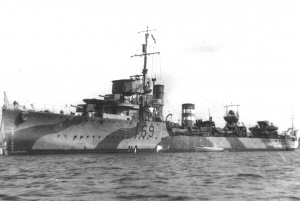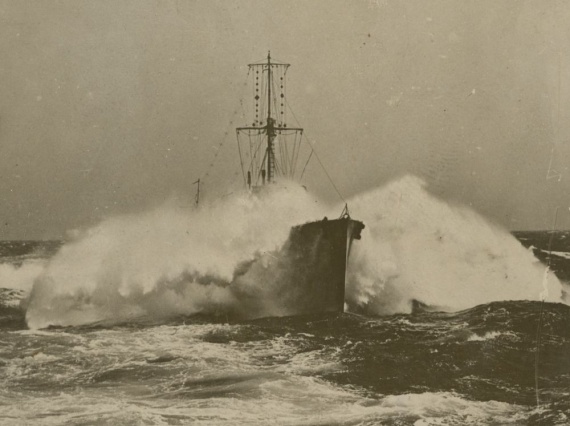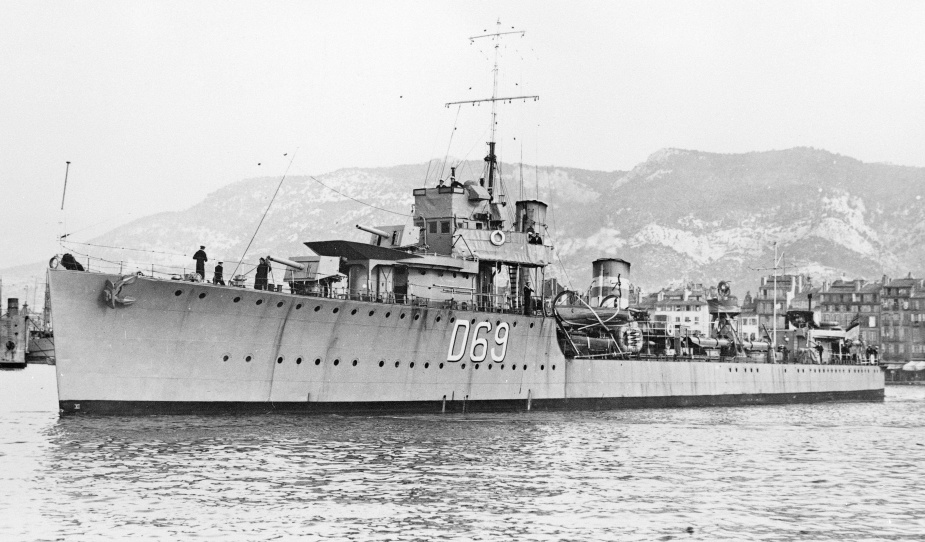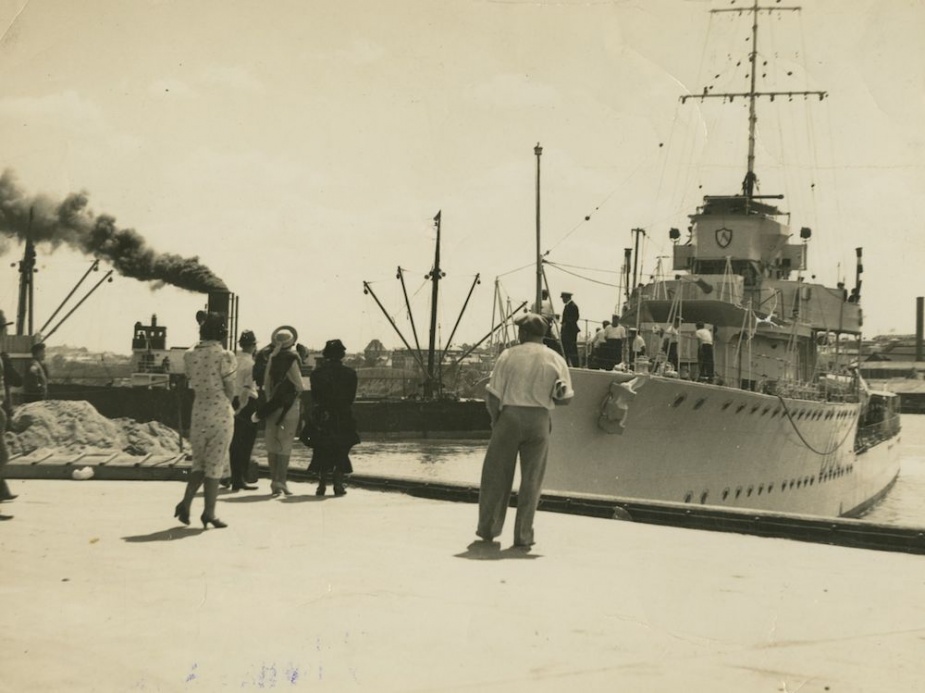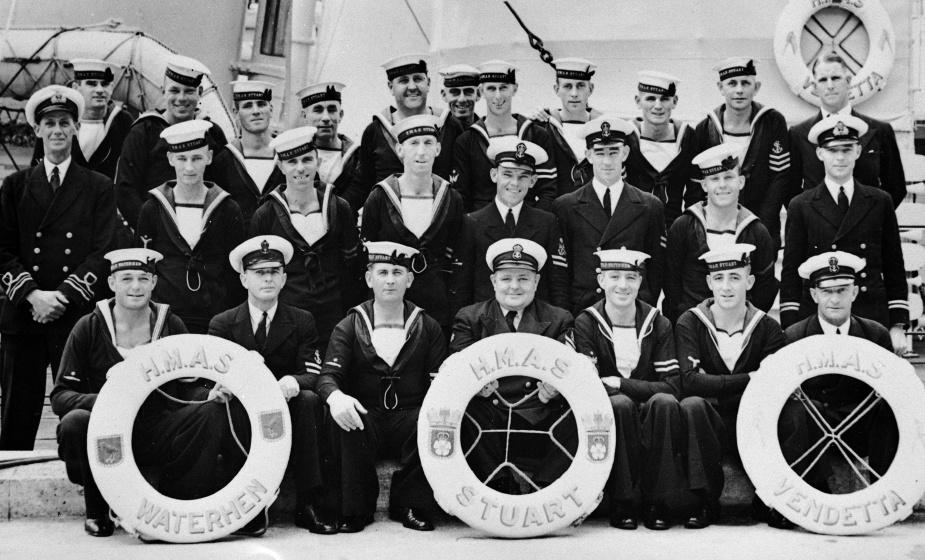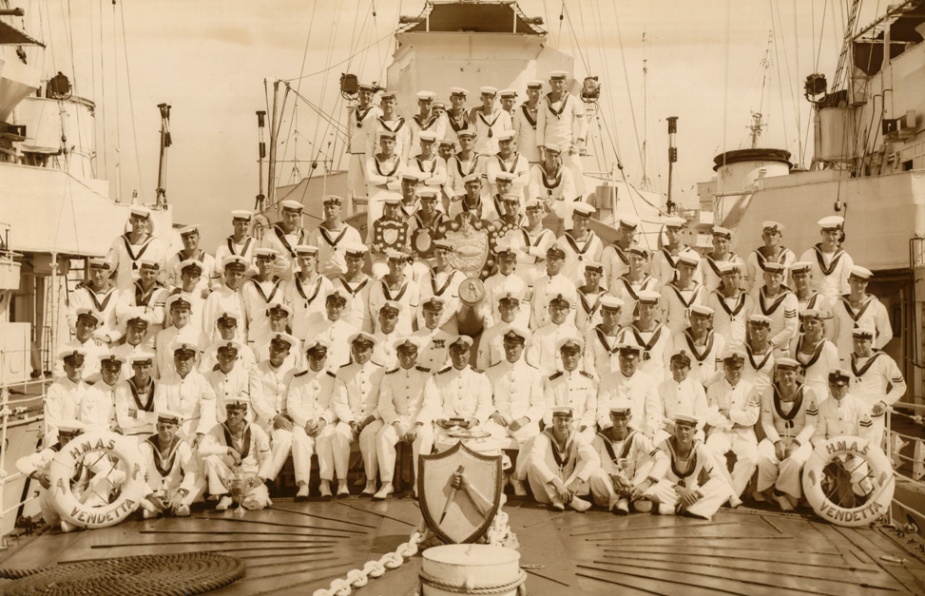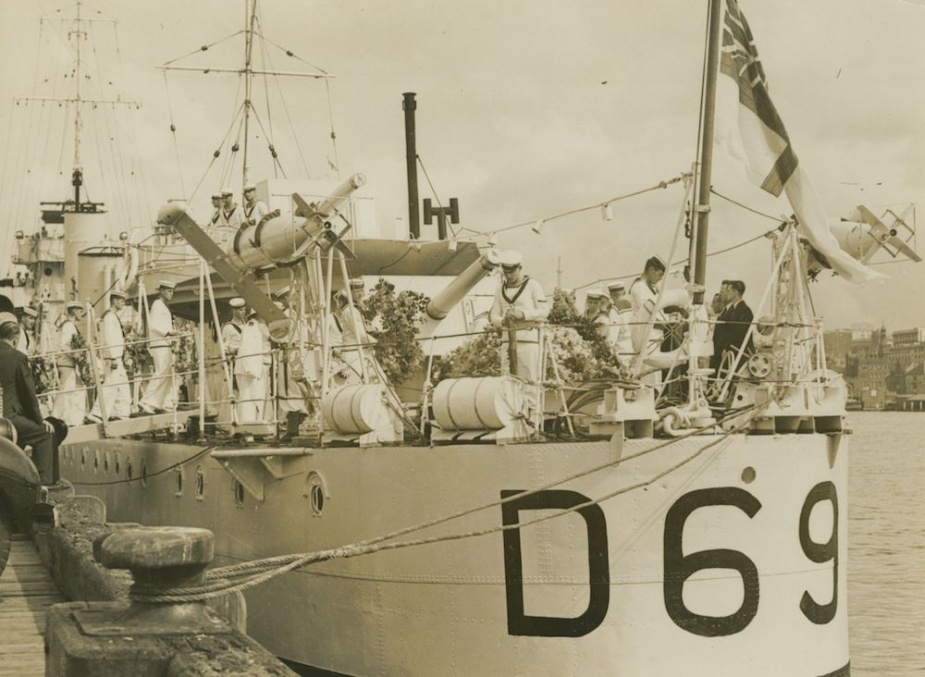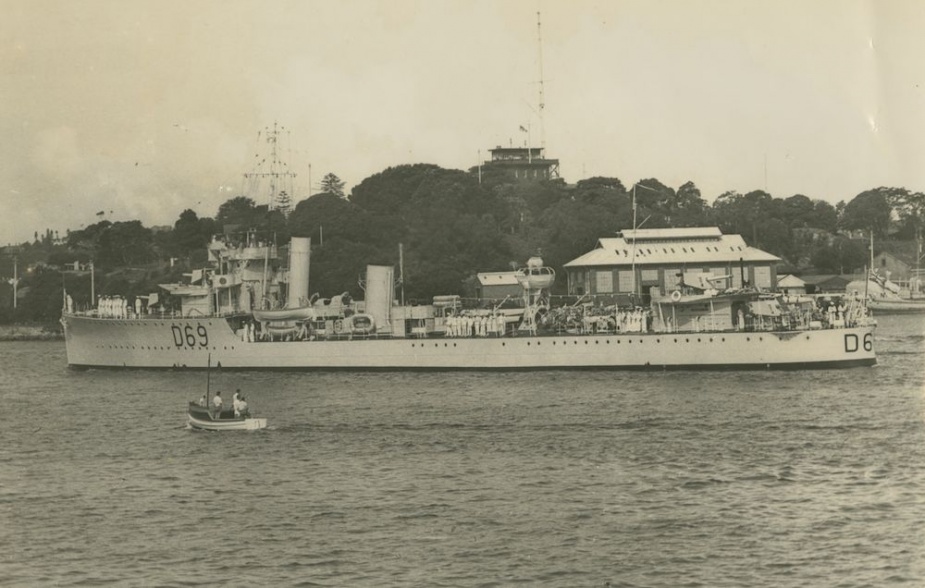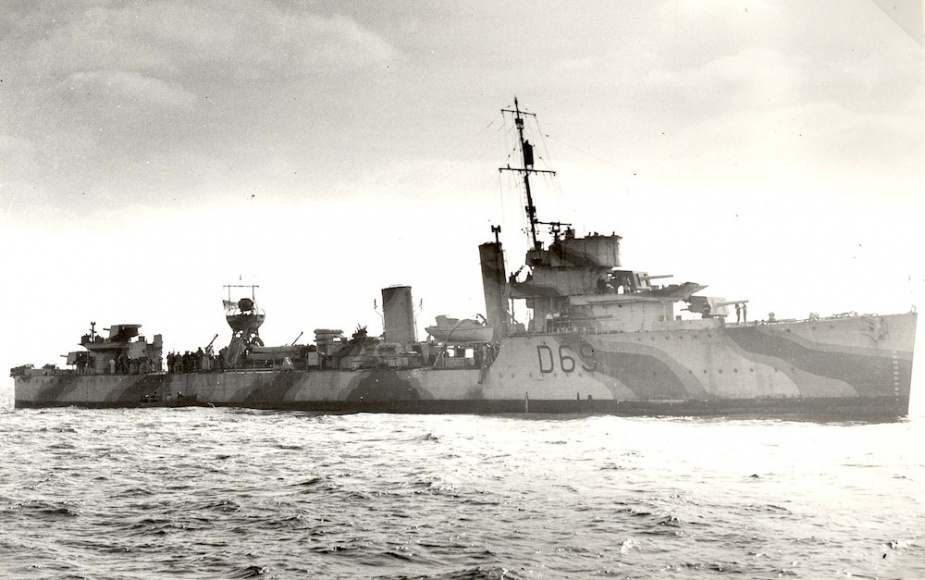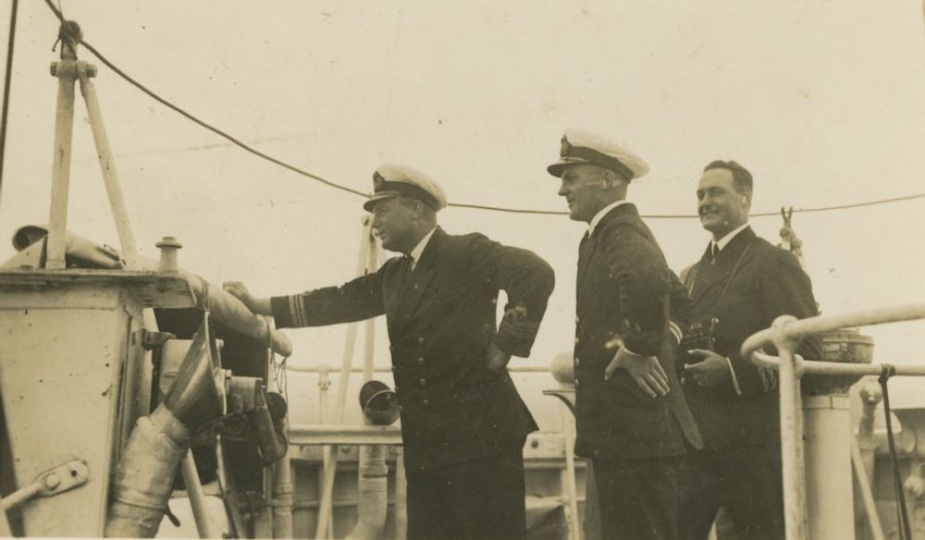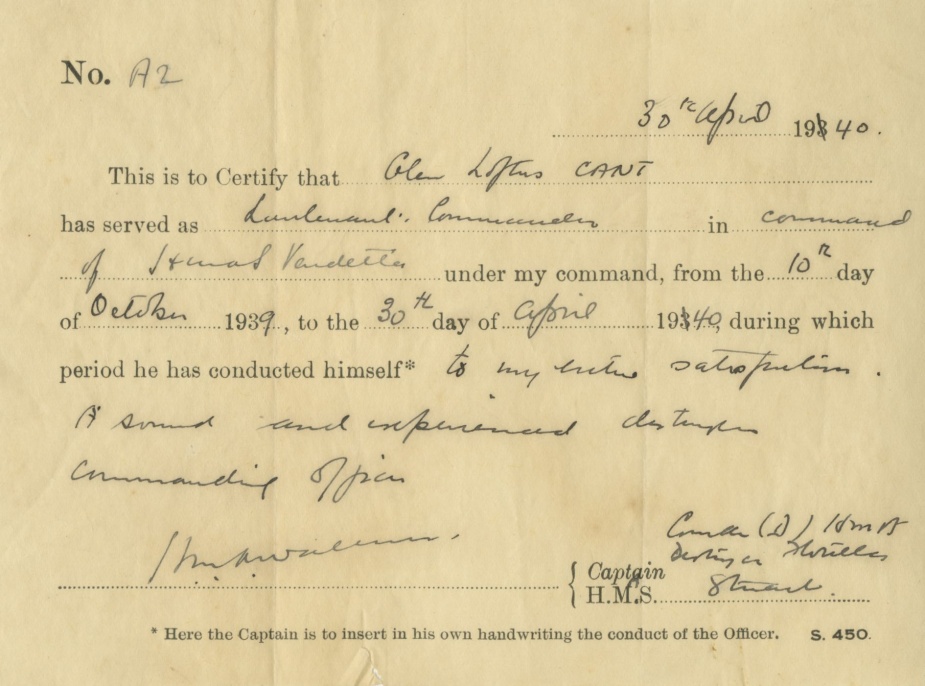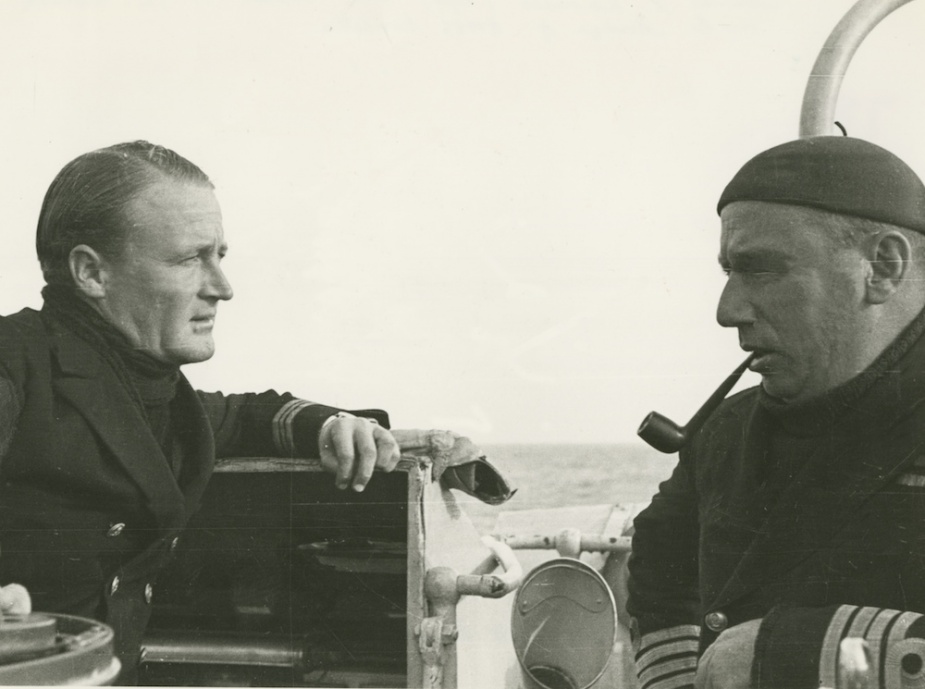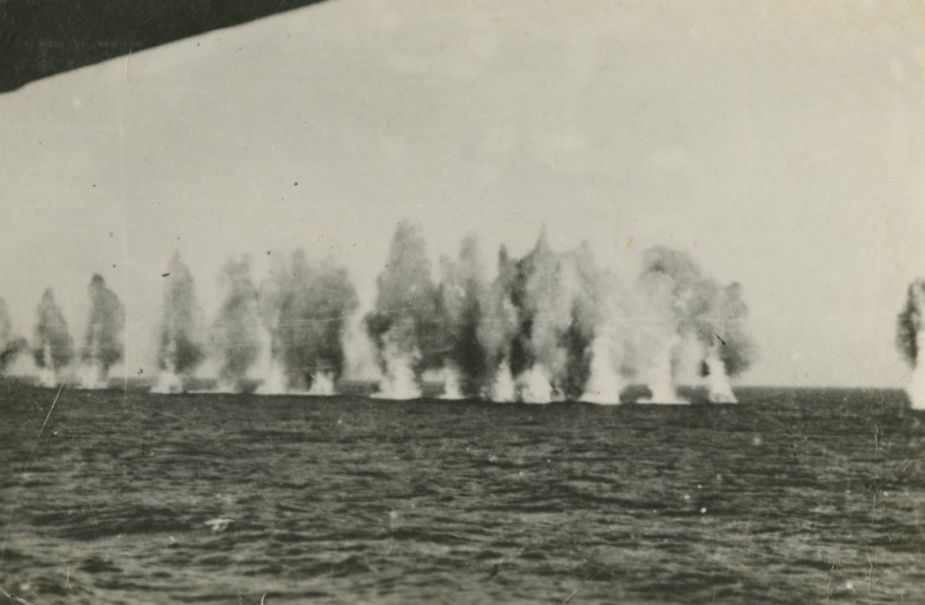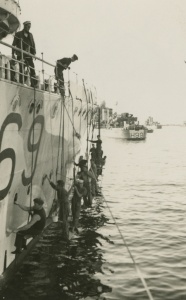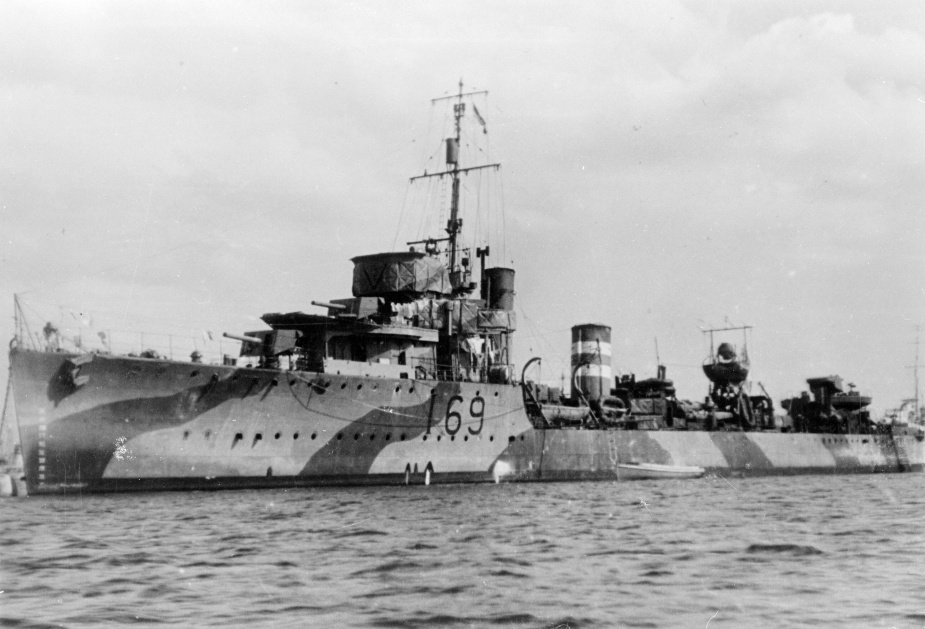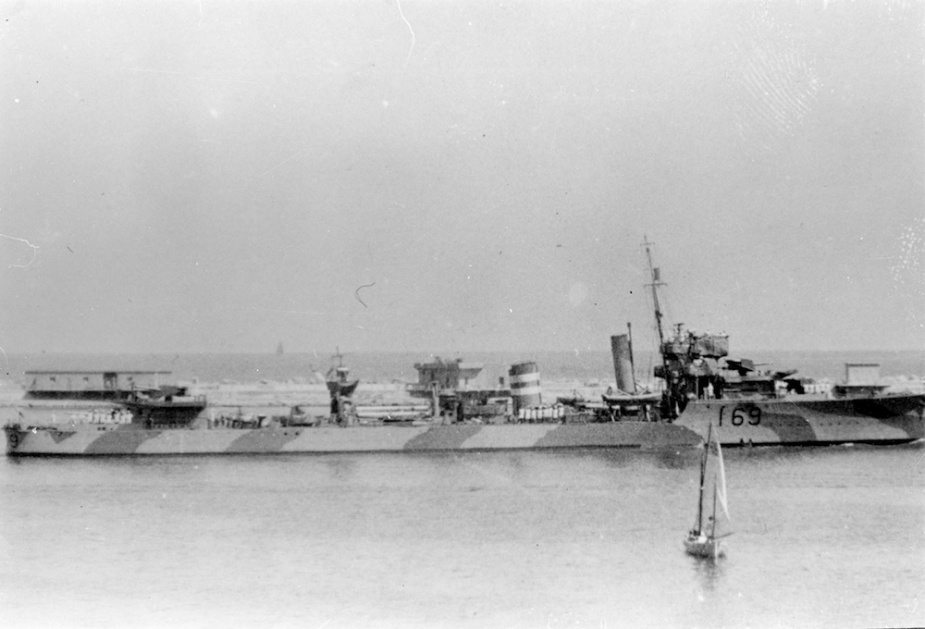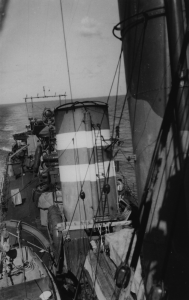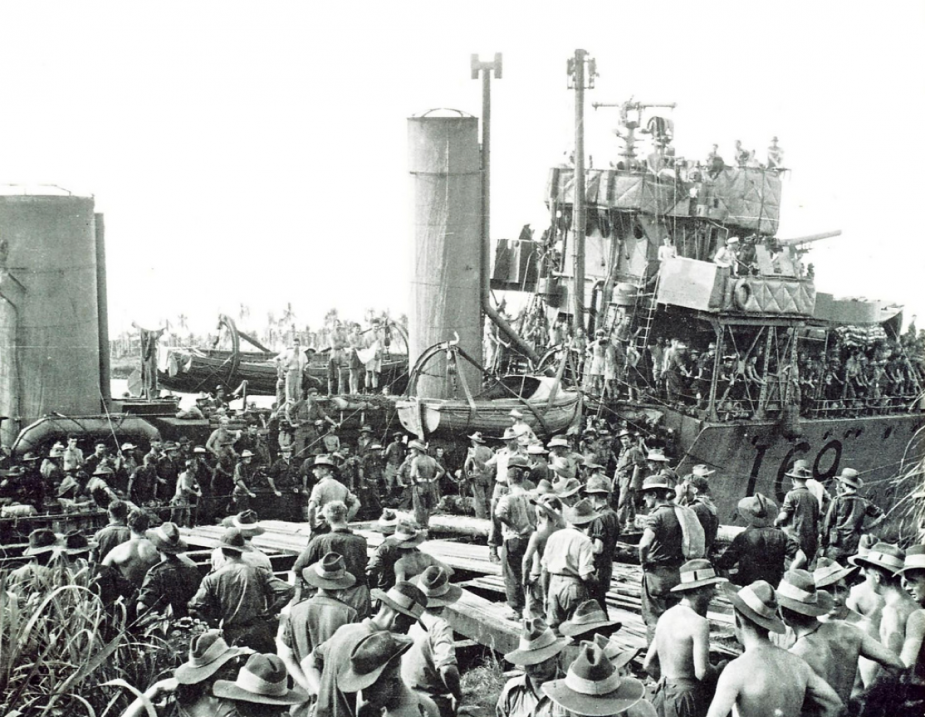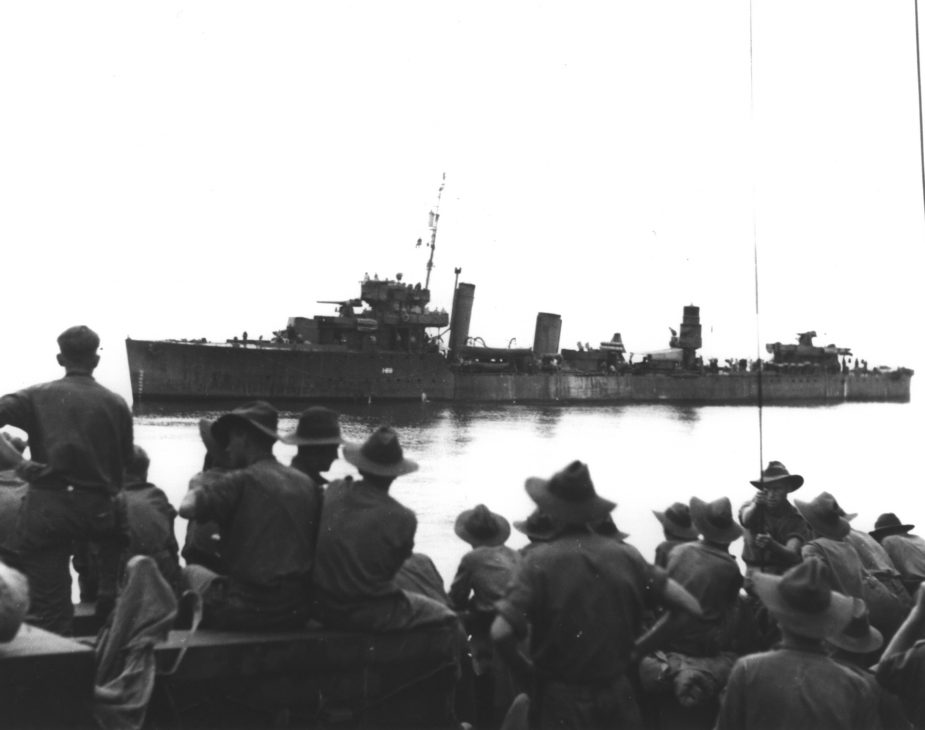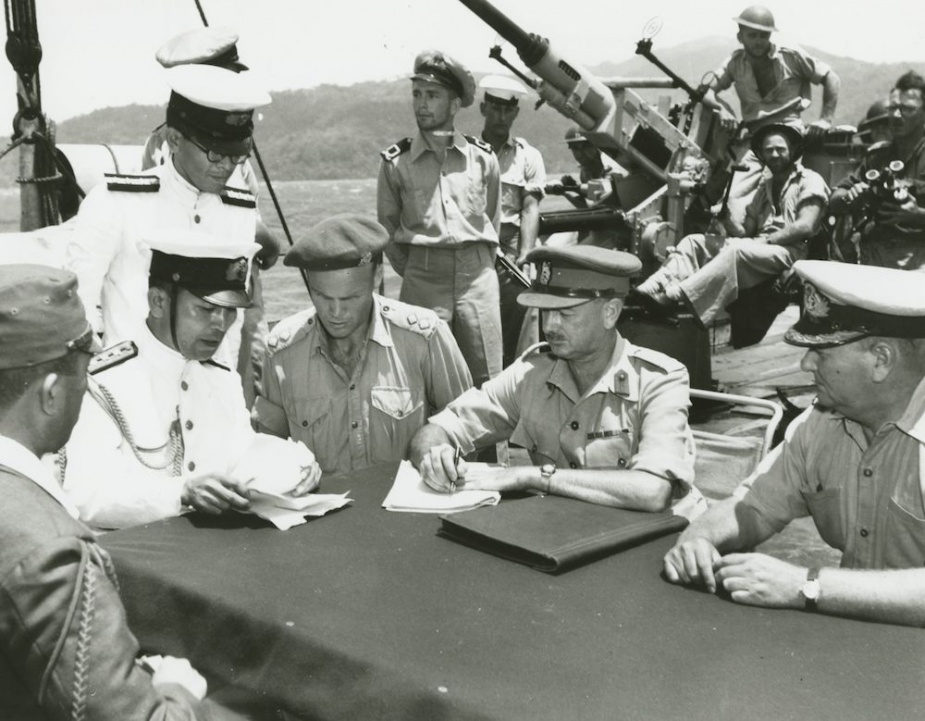HMAS Vendetta (I)
| Class |
V and W Class |
|---|---|
| Type |
Destroyer |
| Pennant |
D69 |
| Builder |
Fairfield Shipbuilding and Engineering Co Ltd, Glasgow, Scotland |
| Laid Down |
25 November 1916 |
| Launched |
3 September 1917 |
| Commissioned |
11 October 1933 |
| Decommissioned |
27 November 1945 |
| Dimensions & Displacement | |
| Displacement |
|
| Length | 312 feet 1 inch |
| Beam | 29 feet 6 inches |
| Draught | 9 feet 8 inches |
| Performance | |
| Speed | 34 knots |
| Complement | |
| Crew | 130 |
| Propulsion | |
| Machinery | Brown-Curtis turbines, twin screws |
| Horsepower | 27,000 |
| Armament | |
| Guns |
|
| Torpedoes | 6 x 21-inch torpedo tudes (triple mount) |
| Other Armament |
|
| Awards | |
| Battle Honours | |
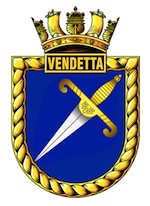
Following commissioning on 17 October 1917, Vendetta joined the 13th Destroyer Flotilla and shortly afterwards saw her first action when on patrol she engaged German minesweepers in the Kattegat.
On 17 November 1917, while operating as a screening destroyer to the 1st Light Cruiser Squadron (HM Ships Caledon, Galatea, Royalist and Inconstant), she took part in the Heligoland Bight action against German cruiser forces. In 1918 Vendetta was engaged as a patrolling destroyer and on fleet escort duties.
On 12 December 1918 in the Baltic she rescued 430 of the total crew of 470 of HMS Cassandra when that vessel struck a mine and sank. Later in the same month as one of the British naval units supporting the White Russian forces, Vendetta engaged and drove ashore on Devil's Rock near Reval, the Bolshevik destroyer Spartak. Early the following year, also off Reval, she assisted in the capture of the Bolshevik destroyer Lennuk.
In 1919 she was engaged towing surrendered German destroyers from Scapa Flow to Rosyth and the following year was present at Zeebrugge when her Commanding Officer, Lieutenant Commander Nash, handed HMS Vindictive over to the Belgians.
In April 1923 Vendetta was again in the Baltic and was inspected by Marshal Pilsudski, President of Poland, at Gdynia. Here the crew met their old adversary Spartak, that had become a unit of the Estonian Navy and renamed Wambola. In the same year she rescued the crew of the Imperial Prince which was wrecked off Aberdeen, Scotland.
In 1924 she served in the Mediterranean with the 5th Flotilla and also in the Red Sea as a patrol vessel during the Jeddah War fought between Ali, King of Hedjaz, and Ibn Saud, Sultan of Nejd. In March 1925 she was one of the escort for the Royal Yacht Victoria and Albert during the Mediterranean tour of His Majesty King George V and Queen Mary. Vendetta spent most of her career from 1924 to 1933 operating in the Mediterranean wit the 1st and 5th Destroyer Flotillas.
In 1933 the Admiralty agreed to loan the Flotilla Leader Stuart and four V and W Class destroyers (Vampire,Vendetta, Voyager, and Waterhen) to the Royal Australian Navy as replacements for the S Class destroyers (Stalwart, Success, Swordsman, Tasmania,, and Tattoo) and the Flotilla Leader Anzac, then due for scrapping. Vendetta and the other four ships were commissioned in the Royal Australian Navy at Portsmouth on 11 October 1933 to form the Australian Destroyer Flotilla, later to become famous as the 'Scrap Iron Flotilla' during World War II. Vendetta was commissioned under the command of Lieutenant Commander Jack Donovan, RAN.
The Flotilla departed Chatham, under the command of Captain AC Lilley, RN (embarked in Stuart), on 17 October 1933 and, proceeding via Suez, reached Singapore on 28 November, Darwin on 7 December and Sydney on 21 December 1933. On 31 January 1934 Vendetta paid off into Reserve.
On 10 October 1934 Vendetta recommissioned at Sydney under the command of Lieutenant Commander Alvord Rosenthal, RAN, to replace Waterhen in the Australian Squadron. She was to serve for the next three years and nine months until she again paid off into Reserve on 1 June 1938.
On 16 October 1934 Vendetta departed Sydney to join the escort of HMS Sussex with His Royal Highness The Duke of Gloucester on board. On 18 October the Australian Squadron comprising the heavy cruisers HMA Ships Australia, Canberra, the destroyers Stuart, Voyager and Vendetta; plus HM Ships Dunedin and Diomede of the New Zealand Division, Royal Navy; and HMIS Hindustan, escorted Sussex through Port Phillip Bay to Melbourne. The ships spent a week at Melbourne taking part in the Victorian Centenary Celebrations with officers and men from the Squadron taking part in a Naval Pageant as well as drill and marching displays. Foreign warships taking part in the celebrations were the French sloop Amiral Charner and the Italian cruiser Armando Diaz, which was later sunk by a British submarine in the Mediterranean during World War II.
Following the visit to Melbourne, Vendetta returned to Sydney and remained in port until March 1935 when she proceeded on a cruise to New Zealand ports. She returned to Sydney on 1 April 1935 to spend the next four months 'swinging round the buoy' at Farm Cove. On 12 August 1935 she sailed with the Squadron (Canberra, Sussex, Stuart, Vendetta and Voyager) on the spring cruise, visiting Queensland ports, Darwin, Fremantle and Melbourne before returning to Sydney on 15 November, having circumnavigated the continent.
Vendetta's service between 1936 and 1938 followed a similar pattern. Between 1 January 1936 and 1 June 1938, when she paid off, more than half of this period was spent in her home port of Sydney. The remainder was taken up by Squadron cruises, exercises and work as a seagoing training ship. Except for a visit to New Zealand in April 1937, the whole period was spent in Australian waters.
Following a brief period in reserve, Vendetta recommissioned on 29 September 1938 under the command of Lieutenant Commander Glen Loftus Cant, RAN. The months preceding the outbreak of World War II were spent mainly in harbour, interspersed with exercises in the waters off New South Wales and a special cruise to convey the body of former Prime Minister JA Lyons from Sydney to Devonport, Tasmania where he was buried on 13 April 1939.
War with Germany broke out on 3 September 1939, and on 14 October 1939 Stuart, Vendetta and Waterhen departed Sydney for Singapore, proceeding via Darwin and Lombok Strait. The same day, Vampire and Voyager departed Fremantle to join them at Singapore. The Flotilla was under the command of Commander HML (Hec) Waller, RAN who was Commander (D), in Stuart.
It had been intended to base the destroyers at Singapore for a period of training but, while the Flotilla was still at sea, it was decided that after a brief stop at Singapore it should proceed to the Mediterranean. The two destroyers from Fremantle arrived at Singapore on 21 October 1939 where they were joined on 29 October by Stuart, Waterhen and Vendetta.
The Flotilla sailed from Singapore on 13 November 1939 but split up en route and consequently the ships did not all reach Malta at the same time; Vendetta arrived on 14 December 1939. From 2 January 1940 the Flotilla formed the 19th Destroyer Division for service with the Mediterranean Fleet.
At this period of the war, British and French naval supremacy in the Mediterranean called for only routine escort and patrol duties, interspersed with fleet exercises. Nevertheless, the Australian destroyers were kept busy with their routine of escort and patrol work, singly and in pairs, which took them from one end of the Mediterranean to the other.
Vendetta entered Alexandria for the first time on 12 January 1940 and until March 1940 her escort and patrol duties took her to Marseilles, Malta, Gibraltar and Haifa.
In April Vendetta spent 13 days in Malta's Grand Harbour, two days at Gibraltar and the remainder of the month patrolling at sea. On 28 April she departed Gibraltar escorting the battleships HMS Malaya and HMS Royal Sovereign to Alexandria. In May 1940 she escorted HMS Warspite to Alexandria, HMS Resource to Malta and HMT Talma to Marseilles. At the close of May she began a refit at Malta where she remained throughout June.
On 27 May the 19th Destroyer Division (HMA Ships Stuart, Vampire, Voyager, Vendetta, and Waterhen) and the 20th Destroyer Division (HM Ships Dainty, Diamond, Decoy and Defender) combined to form the 10th Destroyer Flotilla under the command of Commander Waller.
The entry of Italy into the war on 10 June 1940 and the collapse of French resistance on 22 June completely changed the naval situation in the Mediterranean. Formerly, all coastlines were either Allied or neutral, and the Anglo-French fleets were in undisputed control of the seas. Now all coasts except those of Egypt, Palestine and Cyprus in the east, Malta in the centre, and Gibraltar in the west were closed to the Royal Navy. Moreover, the Allies had lost the support of the French fleet, which had provided seven capital ships and nineteen cruisers, and had acquired a new enemy in Italy with her menacing naval potential. The Italian fleet boasted five battleships, 25 cruisers, 90 destroyers and nearly 100 submarines. It spelt the beginning of a long and bitter struggle for control of the Mediterranean, first against the Italian fleet and air force and later against the much more formidable German Luftwaffe whose dive bombers took a grievous toll of British warships before they were finally driven from the skies.
For more than a year the 'Scrap Iron Flotilla' took part in the struggle for possession of the sea lines of communication linking east and west.
On 8 July 1940 Vendetta completed her refit at Malta - too late to take part in the Battle of Calabria on 9 July 1940. Her War Diary commented that Malta was bombed on nearly 80 occasions between 11 June and 8 July. The defeat of the Italian fleet at Calabria placed the initiative at sea in the Mediterranean firmly in the hands of Admiral Andrew Cunningham, RN commanding the British fleet. Throughout the latter half of the month the fleet cruised at sea to cover several convoys moving across the Aegean without provoking the enemy to retaliation.
On 13 July Vendetta arrived at Alexandria as part of the escort of a convoy from Malta. She spent the following days in harbour and covering the battle fleet at sea. On 24 July she proceeded in company with Vampire, screening the cruiser HMS Orion for a diversionary demonstration off Castelorizo Island. The ships were not sighted from the air and no response came from the defences ashore. The two destroyers reached Port Said on 25 July and sailed the following day escorting the armed boarding vessels HM Ships Chakla and Fiona for a second demonstration. They met Orion on 27 July and that evening proceeded as if to conduct a landing on Castelorizo. Again the Italians refused to be provoked.
The first half of August 1940 was spent escorting convoys between Alexandria and Port Said and Famagusta and Port Said. On 17 August Vendetta sailed from Alexandria in company with of the battle fleet, HM Ships Warspite, Malaya and Ramillies, for Operation MB2- the bombardment of Bardia and Fort Capuzzo on the Libyan coast. Firing lasted from 0658 to 0720, on 18 August, causing considerable damage to enemy installations, particularly at Fort Capuzzo. During the withdrawal air attacks on the fleet began at 1050 and lasted for half an hour without any hits being scored. Fighter cover provided by the Royal Air Force and the Fleet Air Arm resulted in the destruction of eleven Italian aircraft without loss to themselves. The fleet returned to Alexandria shortly before midnight on the same day, where Vendetta remained for the next 11 days.
On 29 August reinforcements for the Mediterranean Fleet arrived at Gibraltar; comprising the battleship HMS Valiant, the new aircraft carrier HMS Illustrious and the cruisers HMS Calcutta and HMS Coventry, named as Force F. To move these new additions to the fleet, from west to east, a large scale operation was prepared which planned cover as far as Sardinia, by forces based at Gibraltar, followed by a rendezvous with the Mediterranean Fleet south of Sicily.
On 30 August the fleet, including Vendetta, sailed from Alexandria to join Force F and to cover the passage of convoy MF2 from Alexandria to Malta (consisting of the Polish destroyer Garland for Gibraltar and a merchant ship convoy (AP2) to Alexandria). Vendetta spent six days screening the fleet during these operations. No surface attack developed though an enemy battle fleet of two battleships, seven cruisers and eight destroyers was sighted by aircraft from HMS Eagle. In the air the enemy reaction was mainly confined to attacks on Convoy MF2 during which one ship was hit. By 07:00 on 5 September most of the fleet was back in Alexandria after the safe passage of British forces through the Sicilian Channel for the first time since Italy had entered the war.
On 13 September the long expected Italian invasion of Egypt began. On 16 September Italian forces occupied Sidi Barrani after a cautious advance from Sollum. As a result the fleet was involved in operations aimed at harassing the enemy advance in support of the British Army of the Nile. In addition to these commitments the Navy was engaged in protecting the increased movement of convoys bringing supplies and reinforcements to the Middle East and Malta. During part of these September operations, the passage of troops to Malta in the cruisers HMS Liverpool and HMS Gloucester, as part of Operation MB5, saw Stuart sink the Italian submarine Gondar and take 47 crew members as prisoners.
Vendetta's duties at this time, however, were confined to local escort. On 12 September she sailed as escort to a two ship convoy to Haifa, then to Port Said where she joined a convoy bound for Alexandria arriving early on 16 September. The remainder of the month was spent in harbour, except for a day at sea exercising with HMS Eagle.
October opened with Vendetta at Alexandria preparing to join the battle fleet at sea on 2 October for Operation BMQ, a fleet sweep into the north west Mediterranean. This operation proved uneventful though both Vendetta and Vampire (I) carried out a series of attacks without result on a confirmed submarine contact.
On 6 October the fleet returned to Alexandria, sailing again two days later to cover the passage of another troopship convoy (Operation MB6) to Malta. On arrival at Malta on 11 October, Vendetta detached with engine trouble and was therefore not present during the following operations when the Italian destroyers Airone, Ariel and Artigliere were sunk.
On 28 October the Italian Army invaded Greece, from Albania, and it followed that the reinforcement of Greece and Crete involved a further commitment for the Mediterranean Fleet. In the first days of November, while Vendetta was completing her refit at Malta, steps were taken to support Greek resistance on land and at sea. A fueling base was established at Suda Bay in Crete and on 1 November the cruiser HMS Ajax landed troops and artillery. A convoy which arrived there on 31 October/1 November consisted of the cruisers Coventry and Calcutte, the net-layer HMS Protector, minesweeper HMS Fareham, armed boarding vessels HMS Fiona and HMS Chalka, oilers Brambleleaf and Olna, and the 10th Flotilla destroyers Waterhen, Vampire, Voyager and Defender. By the evening of 1 November and despite enemy bombing, Ajax had disembarked her troops, Fiona and Chalka were alongside Suda pier unloading stores, Protector had laid her nets and gun sites and ammunition and supply dumps were being established near Suda Point. This was the first of a series of convoys to Suda Bay.
On 4 November convoys departed Port Said and Alexandria for Greece and Suda Bay (convoy AN6) and for Malta (convoy MW3). On 5 November Ajax and HMAS Sydney left Port Said with artillery and administrative troops for Suda Bay. The fleet was at sea to cover these and other convoy movements and to meet further Mediterranean reinforcements which comprised the battleship HMS Barham, the cruisers HMS Berwick and HMS Glasgow and three destroyers, HM Ships Galliant, Greyhound and Griffin.
Vendetta completed her refit on 9 November and the following day sailed from Malta escorting the monitor HMS Terror to Suda Bay and then the SS Brisbane Star to Alexandria. During the period 10-14 November the fleet carried out the successful attack on Taranto on the night of 11 November, and a few hours later the 7th Cruiser Squadron (Orion, Ajax and Sydney (II)) raided the Straits of Otranto, destroying three ships of a four ship convoy off Valona.
On 15 November the military reinforcement of Greece commenced when a fast convoy of four merchant ships sailed from Alexandria for Piraeus, escorted by Coventry, Vampire (I) and Waterhen (I). On the same day Vendetta proceeded as a unit on the screen of the 2nd Division battle fleet cruising to Suda Bay, and thence to Alexandria arriving in harbour on the 19 November.
The next operation of the battle fleet, Operation MB9, in which Vendetta took part covering the passage of convoys to and from Malta, convoys MW4 and ME4, and of two MT ships to Malta and one to Alexandria. It included the first through Mediterranean convoy of merchant ships. An enemy attempt to cut off the east bound convoy south of Sardinia led to the brief engagement with the Italian fleet off Cape Spartivento. As a unit of the large British forces at sea during these operations, Vendetta departed Alexandria on 23 November escorting convoy MW4 (four ships) to Malta. The following day Italian torpedo aircraft attacked but only one succeeded in firing its torpedo which passed harmlessly 500 yards ahead of Vendetta. Malta was reached without further incident on 26 November. Later that day Vendetta departed escorting convoy ME4 for Alexandria and Port Said, arriving unmolested on the last day of November.
On 2 December Vendetta sailed from Port Said with Voyager (I) in company, escorting convoy AN8 bound for Athens, thence to Alexandria. On the day Vendetta returned to Alexandria, 9 December 1940, the British Army under General Archibald Wavell began its offensive in the Western Desert. The immediate object of these operations was the destruction of enemy forces in the Nibeiwa/Tummae area followed by a northward drive to Sidi Barrani on the coast, thus isolating Maktila Camp which represented the Italian Army's most advanced camp in Egypt. The naval role during the first stage of the operations was to provide harassing fire at Maktila and Sidi Barrani, and this was begun by the monitor Terror and the gunboats HM Ships Aphis and Ladybird, supported by the destroyers HM Ships Jervis, Janus, and Nubian during the night of 8/9 December.
On 10 December Vendetta sailed from Alexandria screening the battle fleet (Barham, Valiant, York, and Illustrious) for the bombardment of Bardia, but were prevented from shelling the Italian positions by low visibility. Bad weather also stopped a projected attack on El Adem airfield by aircraft from Illustrious. On 13 December the fleet returned to Alexandria. On 14 December Vendetta joined the Inshore Squadron screening Terror on 15 and 16 December while the monitor bombarded Bardia. On both days the Australian destroyer was straddled by shells from the Italian shore batteries. On 17 December she returned to Alexandria to refuel.
Ashore the British military operations proved a complete success. Sollum and Fort Capuzzo were captured on 16 December and when Vendetta rejoined the Inshore Squadron off Sollum on 18 December the Italians appeared to be rapidly losing their cohesion as a fighting force. With the capture of Sollum the first phase ended and the role of the Navy turned temporarily from offensive action to supply.
During the remainder of December the work of the 10th Flotilla destroyers (Vendetta, Voyager, Waterhen, Vampire (Captain D10), Diamond, and Wryneck) supporting the campaign in the Western Desert was confined to patrol and escort duty. On 26 December Waterhen captured the enemy schooner Tireremo Diritto trying to enter Bardia, and on 29 December Voyager intercepted the schooner Zingarella engaged in transporting British prisoners of war from Bardia to Tobruk. Dainty also captured two schooners on the night of 21 December. On 27 December Vendetta returned to Alexandria where she undertook boiler cleaning until the close of the year.
On 31 December 1940 plans for the assault on Bardia by the 6th Australian Division were completed. The naval contribution to the attack called for harassing fire by Terror and the inshore gunboats all day on 2 January 1941, followed by a heavy bombardment by the fleet on 3 January with further harassing fire from Terror and the gunboats from dawn to 16:00 hours. At this time five destroyers of the 10th Flotilla (Stuart, Vampire, Waterhen, Decoy, and Defender) were non-operational. This left half of the flotilla available (Voyager, Vendetta, Dainty, Diamond, and Wryneck) for the assault on Bardia. Vendetta sailed from Alexandria with the battle fleet on the evening of 2 January with Diamond and Wryneck in company. Voyager (Captain D10) and Dainty joined the screen off Sidi Barrani at 07:00 the following morning after supporting Terror in the shelling of Sollum.
The bombardment commenced at 08:10 on 3 January by Warspite, Valiant and Barham, with destroyers screening and engaging shore batteries on the cliffs on either side of the harbour entrance, while the carrier Illustrious, screened by the 3rd Cruiser Squadron, provided fighter protection. The bombardment which ended at 16:00 and the simultaneous land assault were a complete success.
The following day the Australians entered Bardia and on 5 January the enemy troops defending the encircled south eastern sector surrendered. 45,000 prisoners, 462 guns and 129 tanks were captured. The capture of Bardia ended naval offensive action in the Western Desert Campaign until the attack on Tobruk on 21 January, the Navy reverting to the protection of supplies.
Vendetta now joined the Inshore Squadron which besides the destroyers of the 10th Flotilla, minesweepers and local patrol craft comprised Terror and the gunboats Aphis, Ladybird and Gnat. Between 4-10 January she was engaged on Libyan coast patrols excepting a brief visit to Alexandria when she landed 111 Italian prisoners.
On the other side of the Mediterranean the Italians were faring little better in their attempt to occupy Greece. Thus at this stage the feeble efforts of Italian forces on land and at sea provoked the Germans to intervene in an effort to bolster the Axis position. This they sought to accomplish by the only means open at short notice - the transfer of aircraft to the Mediterranean theatre. The arrival of the Luftwaffe, particularly its dive bombers to reinforce the Italian squadrons operating from Sicilian airfields, was a serious set back to the Mediterranean Fleet, weakening its hitherto almost undisputed control of the Central Mediterranean and curtailing its freedom of movement.
The infusion of German pilots and aircraft soon made itself felt, and in the first encounter during the passage of Greece bound and Malta convoys the Mediterranean Fleet lost the cruiser Southampton, suffered severe damage to the carrier Illustrious, and lesser damage to the cruiser Gloucester. This operation, EXCESS, had as its objective the passage of a convoy from Gibraltar through the Mediterranean to Greece and Malta, and the simultaneous cover of fast convoys from Alexandria to Malta, and Malta to Alexandria, with a fourth slow convoy from Malta to Port Said and Alexandria. In all it comprised the passage of fourteen ships and its protection employed almost the entire British naval strength in the Mediterranean, namely Force H from Gibraltar under Vice Admiral Sir James Somerville, and the bulk of the Mediterranean Fleet from Alexandria under Admiral Cunningham.
Most of the destroyers of the 10th Flotilla (excepting Diamond and Dainty) did not take part in the operations covering the convoys, but on 11 January, Stuart (I), Voyager (I), Vendetta, Vampire (I) and Wyneck sailed from Alexandria escorting Eagle and Barham for Operation MC6. It was intended that Barham and Eagle (Admiral Rawlings) should join the fleet on 12 January to begin attacks on the Italian shipping routes while the convoys were at sea. The disabling of the carrier Illustrious by German air attack put an end to this plan and Admiral Rawlings' group was eventually frustrated by bad weather.
On 18 January Vendetta returned to Alexandria on the screen of Barham and Eagle from Suda Bay. Two days later she sailed escorting convoy AN13 for Piraeus, returning on 27 January as part of the escort for the fifteen ships of AS13. On 1 February she was again at sea with the battle fleet prior to taking up escort duties of a south bound convoy from Crete two days later. On 7 February she was back in Alexandria where she remained refitting until 10 March.
Meanwhile, with the German threat to the Balkans beginning to take shape (Bulgaria joined the Axis forces on 1 March), Britain decided to send military aid to Greece, a decision which imposed a further heavy commitment on the Mediterranean Fleet.
The transport of the troops and equipment began on 5 March with the first flight of 'Lustre Force' as it was known and continued until 24 April when 58,000 troops, with all their stores and fighting equipment, had been transported from Egypt to Greece. The passage to the Piraeus, virtually the only port available for disembarkation, led past enemy bases in the Dodecanese, from which they were able to launch attacks against the British line of communication. In spite of this advantageous strategic position, however, they failed to halt the steady flow of men and material and excepting a few bomb splinter casualties in one ship all arrived safely. The losses sustained, six ships, were all vessels proceeding in the convoys but not part of the 'Lustre' movement or vessels returning empty to Egypt.
All the Australian destroyers and the light cruiser HMAS Perth were involved in this operation. On 11 March Vendetta departed Alexandria escorting convoy AN20, returning on 21 March with convoy AS21. The following day she was at sea again with convoy AN22 which arrived safely in spite of a series of attacks from torpedo aircraft on 24 March. At this stage of the movement, there appeared a number of indications that the Italians intended some form of attack to provide a counterpart to the efforts of the Luftwaffe in the Eastern Mediterranean.
On 26 March Admiral Cunningham, coming to the conclusion that the projected enemy attack would take the form of a large scale air attack on the convoys or a surface sortie into the Aegean, decided to clear the area of convoys while at the same time taking measures to inflict maximum damage to any enemy forces at sea.
The following day, 27 March, Vendetta joined the Vice Admiral Light Forces (Vice Admiral HD Pridham-Wippell) commanding a force which comprised Orion (Flag), Ajax, Perth, Gloucester, and the 2nd Destroyer Flotilla, under orders to join the battle fleet of Warspite, Barham, Valiant, Formidable, and nine destroyers including the 10th Flotilla (under Captain HML Waller, RAN) south of Crete late on the following day if no developments occurred. Thus was the stage set for the Battle of Matapan.
At 08:00 on 28 March Orion sighted two 8-inch and two 6-inch Italian cruisers screened by three destroyers, some 70 miles south of Gavdo Island. At 08:14 the enemy opened fire at about 26,000 yards, and for the next three quarters of an hour Admiral Wippell's force was engaged in a running fight, neither side suffering any damage. At 08:59, however, the Italian ships turned to port on a course of 300 degrees and headed for home at maximum speed. The British ships conformed and a chase developed.
At 09:30, Vendetta, unable to maintain the pace, was ordered to detach and join the battle fleet which she sighted shortly after noon. An hour after joining, engine trouble made it necessary to proceed to Alexandria, and she took no part in the subsequent operations leading to a great tactical success and the destruction of three of the Italian 8-inch cruisers, and two of her largest and fastest destroyers. As Admiral Cunningham commented, 'we were able off Matapan to teach them a lesson which kept them out of the ring for the rest of the year.'
The refit of Vendetta's engines was completed on 4 April, and on the same day she proceeded with Waterhen (I) to join the Inshore Squadron at Tobruk, which had been captured by the British forces on 22 January. Operations on patrol off the Libyan coast and escort duties between Alexandria and Tobruk, which was suffering steadily mounting attacks from the air, kept Vendetta busy until 17 April. On that day at sea with HMS Greyhound she sank an enemy schooner attempting to run the blockade, before proceeding to a rendezvous with an Alexandria bound convoy.
On 21 April she resumed escort duties to the 'Lustre' convoys joining AN29, the last one to leave Alexandria. It reached Suda Bay in Crete on 24 April where it had been diverted owing to the chaotic conditions at the Piraeus and the decision made that day to withdraw British forces from Greece. Operation DEMON, the evacuation of Greece, began on the night of 24/25 April in the face of a rapidly deteriorating military position ashore, culminating in the German entry into Athens three days later.
The rescue of British troops involved the use of all the light forces of the Mediterranean Fleet except the cruiser Gloucester and four J Class destroyers of the Malta Force. They included six cruisers, nineteen destroyers, three escort vessels and corvettes and lighters. Three 'Glen' ships with their specially equipped landing craft and eight transports were also used.
In the entire operation, in which Perth (I) and all of the Australian destroyers took part, 50,672 troops were evacuated, about 80% of the original forces landed. All but those lost in the transport Slamat were safely landed in Suda Bay. But the operation was not accomplished without loss; Diamond and Wryneck of the 10th Flotilla were sunk after rescuing Slamat survivors, as were the transports Ulster Prince and Pennland. Several other ships were also damaged.
Vendetta's part in the evacuation began on 25 April when at 13:15 she sailed from Suda Bay in company with Waterhen (I). Both ships arrived off the beach at Megara at 22:00 where they joined Coventry, Wryneck, Diamond, Griffin, and the transport Thurland Castle. The evacuation, which was completed without interference from the enemy, was completed about 04:30 - Decoy, Hasty and Havock assisting in place of the transport Pennland which was sunk en route. About 5700 troops were embarked, Vendetta taking on board 350 by whaler and skiff. Suda Bay was reached without loss in spite of air attacks at 07:30, 11:10 (12 Stukas) and 11:55 (three Junkers 88).
On the night of 26/27 April, 21,400 troops were embarked in 27 ships, warships and transports. Vendetta took no part in this lift but at 04:50 on 27 April she sailed from Suda Bay in company with Waterhen (I) and Wryneck to escort the main convoy proceeding direct to Alexandria. The following three days were spent at sea screening the battle fleet and five days repairing at Alexandria, ferrying reinforcements to Tobruk and transferring 340 wounded to Mersa Matruh.
Meanwhile, the effort to reinforce and supply the troops in Crete was proceeding in spite of German control in the air, and on 11 May Vendetta sailed to escort AP31 for Suda Bay, returning to Alexandria on 16 May.
On 20 May the Germans launched the invasion of Crete by parachute and glider. In the face of absolute enemy superiority in the air, the Navy did all it could in spite of grievous losses to save the island from German occupation and when defence became no longer possible it managed to extricate some 17,000 troops from the island. Between 20 May and 1 June, when the evacuation of Crete ended, the Mediterranean Fleet lost the cruisers Gloucester, Calcutta, York and Fiji; the destroyers Juno, Greyhound, Kelly, Kashmir, Imperial and Hereward; one minesweeper and 29 smaller craft. Barham, Warspite, Valiant and several cruisers were damaged. Vendetta spent some of this disastrous period screening the battle fleet south of Crete between 21 and 26 May.
On 26 May her crew witnessed a mass attack of German aircraft on Formidable some 150 miles south of Kaso Strait. Formidable was severely damaged, and Nubian, one of the screening destroyers, had her stern blown off. The following day Vendetta returned to Alexandria escorting the damaged carrier.
At this time the effort to supply beleaguered Tobruk was becoming increasingly difficult, and in the face of mounting losses in the harbour from air attack it was decided to discontinue the use of merchant ships. The task of supplying the garrison and evacuating the wounded was thus entrusted from the beginning of June 1941 onwards mainly to the destroyers of the 10th Flotilla and some sloops, aided later by the fast minelayers Abdiel and Latona.
Commencing on 29 May when she sailed from Alexandria with 150 troops and 25 tons of stores, and ending on 2 August, when she entered Tobruk for the last time, Vendetta was constantly at work ferrying men and material. In that time she embarked for passage 4,263 troops, 220 prisoners of war and carried 616 tons of stores and ammunition into Tobruk. She made eleven runs from Alexandria, besides operating between Tobruk and Mersa Matruh. In all she sailed out of Tobruk Harbour 19 times. It was arduous and dangerous work and several ships suffered damage and casualties.
On 24 June Auckland was sunk when attacked by 48 Junkers aircraft. HMAS Parramatta (II), by skillful handling, escaped damage, shot down three aircraft and rescued 162 of Auckland's crew. On 29 June Waterhen (I) was so severely damaged that she capsized while under tow the following day. On 9 July Decoy was damaged by a near miss. On 11 July Vendetta and Defender, en route from Tobruk to Alexandria, were attacked by moonlight by bombers. Defender suffered a direct hit which broke her back, and she too was lost in spite of Vendetta's attempts to tow her to safety.
Vendetta spent the first few days of August 1941 at Alexandria. On 10 August she proceeded to Haifa where she spent 16 days in refit, returning to Alexandria at the close of the month.
In September, after a period as emergency destroyer at Alexandria, she resumed convoy escort duty operating mainly from Port Said to Famagusta and Haifa. Except for four days at Alexandria, she continued this work until 13 October when she arrived at Alexandria for boiler cleaning in preparation for her impending departure from the Mediterranean.
On 20 October Vendetta sailed from Alexandria for the last time after almost two years continuous Mediterranean service. The old destroyer was now in dire need of a major refit. The operations on the Tobruk run, when she had been compelled to operate at maximum speeds, had taken its toll of her engines and she was in little better shape than her sister ship Vampire (I), which had been forced to withdraw at the close of May. On 25 October she arrived at Aden and proceeding the next day reached Bombay on 1 November and Singapore on 12 November, where she passed into dockyard hands for refit.
When war broke out in the Pacific, her Commanding Officer, Lieutenant WG Whitting RANR, was faced with the problem of making the best use of an immobilised ship and her crew. The Japanese bombed Singapore in the early hours of 8 December 1941, and at 04:20 one stick of bombs fell between Vendetta and Ghost Island, a distance of about 200 yards away.
Accompanied by Gunner (T) Mr J Lace RAN, Lieutenant Whitting proceeded to the naval base and reported to the Senior Naval Officer on the disposition of the ship's company with regard to the defence of the Singapore Harbour Board, as this important establishment had no defence of any kind against aerial attack. With the assistance of the Singapore Harbour Board, the 12-pounder gun was mounted on the wharf astern of Vendetta, four machine gun posts were built in the vicinity of King's Dock, and all available Lewis guns were mounted. The ship's company was divided into two watches for anti-aircraft defence and continued to man their anti-aircraft defences night and day continuously up until the day of departure. Lieutenant Whitting became the Officer of Quarters for the 12-pounder for day defence while the Gunner Lace became the Officer of Quarters for the Lewis gun posts by day. At night they took turns as the Officer of Quarters for the 12-pounder. The engineer officer was in charge of the stoker fire party.
At 23:30 on New Year's Eve they had their first real taste of Japanese air attack. A squadron of 54 planes bombed the city. Vendetta's anti-aircraft gun went into action immediately and her bark, which was to become well known in the future, was heard for the first time in south east Asia. From then on they were subjected to constant air attack by day and night.
Singapore experienced its worst blitz on 21 January 1942 when it was attacked by 125 bombers. When a squadron of 27 planes flying low over Keppel Harbour suddenly appeared astern of Vendetta, the 12-pounder immediately went into action. One 12-pounder high explosive shell hit one of the bombers in the bomb rack and she instantly blew up, damaging the planes on either side with the flying debris.
Throughout the remainder of January 1942, while under constant air attack and with the battle for Singapore rapidly approaching its climax, Vendetta's crew worked hard to prepare her for sea and salvaged all the equipment and stores possible. On 2 February 1942 she was taken in tow by HMT St Just and proceeded to rendezvous with HMS Stronghold. When some seven miles out of Keppel Harbour, 54 bombers passed overhead on their way to bomb Singapore, where they severely damaged the King's Dock including the wharf which Vendetta had vacated just two hours before. Later that day Stronghold temporarily took over tow.
The following day Vendetta was attacked at frequent intervals throughout the day, Lieutenant Whitting commenting 'Our 12-pounder HA was continuously in action.' Although she was near missed again and again and damaged by splinters, she was not hit. The next day she arrived safely at Palembang in Sumatra.
On 8 February she was taken in tow by HMAS Yarra (II) and taken to Batavia, arriving on 10 February and where she remained until 17 February when Ping Wo began the long haul to Australia, Yarra (II) escorting until relieved by HMAS Adelaide on 24 February. Fremantle was reached on 3 March. Vendetta left Fremantle on 4 March and at King George Sound on 24 March, the tow was transferred from Ping Wo to SS Islander for the remainder of the voyage to Melbourne. On 15 April Vendetta she reached Port Phillip Bay after a nightmare voyage across the Great Australian Bight in heavy seas. She was at sea under tow for forty days, the total journey having taken 72 days and the tow having parted five times. There was no power in the ship, no sanitary arrangements and due to the absence of refrigeration only tinned food was available to sustain her crew. For his part in bringing Vendetta safely to port Lieutenant Whitting was awarded the Distinguished Service Cross (DSC).
From April to September 1942, Vendetta was refitting at Melbourne. On 29 September Vendetta recommissioned at Melbourne under the command of Lieutenant Commander CJ Stephenson, RAN. She proceeded to Sydney on 14 October where she resumed her refit at Garden Island, work being completed in mid-December.
Vendetta spent January 1943 in Queensland waters exercising and on convoy escort duty. On 10 February she proceeded to Darwin escorting RFA Bishopedale, arriving on 17 February. The following day she sailed to search for a crashed Allied bomber, and sighting a flare some 60 miles off the Timor coast, rescued four survivors. At the close of the month she returned to Townsville escorting Bishopedale.
In March she continued escort duties, screening Taroona on three voyages between New Guinea and Townsville. On 31 March Lieutenant David Logan, RAN assumed temporary command. In April she made four voyages to Port Moresby and Milne Bay escorting transports. There were no incidents though at this period Japanese submarines of the 3rd Squadron were operating along Australia's eastern seaboard. On 11 April they sank the Recina, on 24 April the Kowarra, on 26 April the Limerick, on 27 April Lydia M. Childs and on 29 April the Wollongbar. In all a total of 25,000 tons of valuable shipping with the loss of 87 lives.
In May 1943 Vendetta transferred to coastal escort duty, escorting some of the bi-weekly convoys running between Brisbane and Townsville. On 18 May Lieutenant Commander John Plunkett-Cole RAN assumed command from Lieutenant Logan. In June she returned to Special Ship escort duty on the Queensland coast.
The three months ending September 1943 were all spent in Queensland and New South Wales, mainly escorting Special Ships and on anti-submarine exercises. It was an uneventful period of routine work with little to relieve the monotony of long days at sea, for though Vendetta was at this time far from the operational areas she was nevertheless constantly at work, steaming more than 18,000 miles in the quarter ending September 1943.
Vendetta spent the period of October to December 1943 based at Brisbane on escort duty in Queensland waters. She steamed 13,477 miles and spent ten days in dockyard hands. On 9 December Lieutenant Commander Jack Mesley, RAN assumed command.
In January 1944 Vendetta escorted USS Copahee from Brisbane to Sydney, where she remained in refit until 11 February when she proceeded to Milne Bay. She remained in New Guinea waters on local escort to Milne Bay until 2 March when condenser tube trouble forced her to return to Sydney. On 13 April Vendetta returned to New Guinea waters and for the remainder of the month was engaged in transporting troops and stores to Madang.
In May she continued her role of destroyer transport, landing 501 troops and 53 tons of stores at Madang between 1 and 6 May, before once more returning to the mainland for repairs which kept her in dockyard hands for most of the remainder of the month.
On 2 June Vendetta returned to Milne Bay where she remained for a few days exercising. On 8 June she arrived at Langemak to await the formation of a convoy for Hollandia. Comprising fourteen ships it sailed on 10 June and represented Vendetta's first duty as escort to a large New Guinea convoy proceeding to the newly won Allied base at Hollandia. On 14 June she sailed with HMAS Strahan and US Ships Eichenberger, Craig and Lovelace, escorting an empty south bound convoy of 7 ships for Langemak.
On 23 June at Langemak, Vendetta embarked three Special Unit (Allied Intelligence Bureau) personnel for passage to Waterfall Bay in New Britain, 80 miles from Japanese occupied Rabaul. The landing was carried out without mishap and using her motorboat towing the whaler, embarked three AIB officers and 53 native guerillas for Langemak.
At the close of June 1944 she escorted another large convoy of 18 ships from Langemak to Humboldt Bay. In July Vendetta continued escort and general transport duties in New Guinea waters. At this time the operational area for Australian escort vessels did not extend beyond Wakde Island, but on 23 July Vendetta and HMAS Geelong were ordered to escort an urgent convoy of three ships to Bosnik. After seeing the convoy safely to its destination, Vendetta investigated Sorido Lagoon at Biak and the anchorage at Mios Woendi before returning to Hollandia. On 27 July she fired her first hostile shots in the Pacific campaign when she sank a small boat containing two Japanese who escaped to shore.
In August Vendetta continued operating with the New Guinea escort group until mid month when she proceeded to Brisbane for refit, which kept her in dockyard hands throughout September. On 26 September 1944 Lieutenant William Cook, RAN assumed command.
Vendetta returned to New Guinea waters on 14 October, spending most of the month on gunnery and anti-submarine exercises. On 2 November she sailed in company with HMA Ships Swan and Barcoo, escorting the American transport Cape Alexander, which was carrying 1100 AIF troops for the landing at Jacquinot Bay, New Britain. The landing was unopposed and after seeing the troops safely ashore, the Australian units spent a day bombarding the Japanese positions at Wide Bay. Following this welcome diversion, Vendetta resumed convoy escort duties, operating as far as Morotai. Lieutenant Gilbert Gordon, RAN assumed command on 9 November.
December followed the usual pattern for Vendetta, operating between Mios Woendi and Morotai, although relieving the monotony there was a voyage to Palau escorting USS Acontias and seventeen PT Boats. At Palau Vendetta anchored alongside the American battleships California, Pennsylvania, New Mexico and Mississippi, fresh from their victorious action in the Surigao Strait against Vice Admiral Nishimura's forces. Vendetta returned to Mios Woendi on Christmas Day. At the close of the year she had steamed 106,000 miles since recommissioning on 29 September 1942.
On 9 January 1945 Vendetta bombarded the Anumb River area in New Guinea, firing 206 rounds of 4-inch ammunition at three specified targets. Between 11 and 13 January she escorted was escorting the submarine USS Stingray. On 14 January she arrived at Biak to escort a slow convoy to Morotai, thereafter operating on the anti-submarine patrol off the harbour entrance. On 20 January she sailed for Morotai escorting a tanker and two Liberty Ships. On 28 January she arrived at Noemfoor Island to transport troops and stores to Morotai. Vendetta's duties in February 1945 followed a similar pattern with most of the month spent in the Biak and Morotai areas.
On 1 March she arrived at Hollandia where she relieved HMAS Katoomba on the anti-submarine patrol until 6 March. After three days in harbour she resumed the anti-submarine patrol until 13 March when she proceeded to Brisbane for refit, arriving on 20 March and bringing her war service to a close.
Lieutenant William Tapp, RAN assumed command of Vendetta on 31 May 1945 while she was still in dockyard hands at Brisbane. The refit was completed on 18 August. After trials Vendetta proceeded to Langemak and then to Madang, arriving on 27 August.
On 2 September 1945 she embarked Brigadier Sheehan and his staff, and the Naval Officer-in-Charge, New Guinea, and his staff. She proceeded to Rabaul to meet envoys from General Imamura to arrange details of the formal surrender of the Japanese South East Area Forces, due to take place on board HMS Glory on 6 September.
Vendetta remained in New Britain waters until 11 September when she proceeded for New Guinea, arriving in Madang early on 12 September. On 26 September she departed for Brisbane and then Sydney, where she arrived flying her paying off pennant on 3 October. Two days later, on 5 October, Vendetta moved under her own power for the last time when she slipped from her moorings and was secured alongside the Cruiser Wharf at Garden Island. She had steamed 120,639 miles during her Pacific campaign service.
Vendetta paid off for disposal on 27 November 1945. On 20 March 1946 she was sold to Penguin Pty Ltd, Sydney. Her hull was scuttled off Sydney Heads on 2 July 1948.
Further reading
Scrap Iron Destroyers: The Story of HMA Ships Stuart, Vampire, Vendetta, Voyager and Waterhen by LJ Lind and A Payne - published by the Naval Historical Society of Australia, Garden Island 1976.

